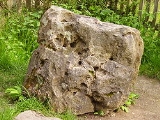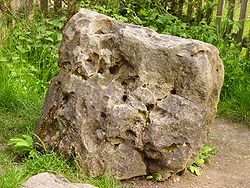
Blowing Stone
Encyclopedia

Sarsen
Sarsen stones are sandstone blocks found in quantity in the United Kingdom on Salisbury Plain, the Marlborough Downs, in Kent, and in smaller quantities in Berkshire, Essex, Oxfordshire, Dorset and Hampshire...
stone, located at in a garden at the foot of Blowingstone Hill just south of the Icknield Way (B4507)
Icknield Way
The Icknield Way is an ancient trackway in southern England. It follows the chalk escarpment that includes the Berkshire Downs and Chiltern Hills.-Background:...
, at Kingston Lisle
Kingston Lisle
Kingston Lisle is a village and civil parish in the Vale of White Horse, England. Kingston Lisle was part of Berkshire until the 1974 local government boundary changes transferred the Vale of White Horse to Oxfordshire.-Location:...
, near Uffington
Uffington, Oxfordshire
Uffington is a village and civil parish about south of Faringdon. It was part of Berkshire until the 1974 boundary changes transferred it to Oxfordshire. Uffington is most commonly known as the location of the Uffington White Horse hill figure....
, in the English
England
England is a country that is part of the United Kingdom. It shares land borders with Scotland to the north and Wales to the west; the Irish Sea is to the north west, the Celtic Sea to the south west, with the North Sea to the east and the English Channel to the south separating it from continental...
county of Oxfordshire
Oxfordshire
Oxfordshire is a county in the South East region of England, bordering on Warwickshire and Northamptonshire , Buckinghamshire , Berkshire , Wiltshire and Gloucestershire ....
(formerly Berkshire
Berkshire
Berkshire is a historic county in the South of England. It is also often referred to as the Royal County of Berkshire because of the presence of the royal residence of Windsor Castle in the county; this usage, which dates to the 19th century at least, was recognised by the Queen in 1957, and...
).
Notability
The stone is capable of producing a booming sound, when anyone with the required skill blows into one of the perforations in a particular way. This was, according to legend, the means whereby King Alfred summoned his SaxonAnglo-Saxons
Anglo-Saxon is a term used by historians to designate the Germanic tribes who invaded and settled the south and east of Great Britain beginning in the early 5th century AD, and the period from their creation of the English nation to the Norman conquest. The Anglo-Saxon Era denotes the period of...
troops, in readiness for the nearby Battle of Ashdown
Battle of Ashdown
The Battle of Ashdown, in Berkshire , took place on 8 January 871. Alfred the Great, then a prince of only twenty-one, led the West Saxon army of his brother, King Ethelred, in a victorious battle against the invading Danes.Accounts of the battle are based to a large extent on Asser's "Life of...
, against the Vikings. This legend reputedly gives rise to the village's name, 'King's stone', the Lisle suffix being a later addition.
Also, according to legend, a person who is capable of making the blowing stone sound a note which is audible atop Uffington White Horse
Uffington White Horse
The Uffington White Horse is a highly stylised prehistoric hill figure, 110 m long , formed from deep trenches filled with crushed white chalk...
Hill (where Victorian antiquarians thought King Alfred's troops had camped) will be a future King of England.
Blowingstone Hill is part of the scarp slope of the White Horse Hills, in the Berkshire Downs
Berkshire Downs
The Berkshire Downs are a range of chalk downland hills in southern England, part of the North Wessex Downs Area of Outstanding Natural Beauty...
and at its crest is the Ridgeway.
Literature
The stone is mentioned in the Thomas HughesThomas Hughes
Thomas Hughes was an English lawyer and author. He is most famous for his novel Tom Brown's Schooldays , a semi-autobiographical work set at Rugby School, which Hughes had attended. It had a lesser-known sequel, Tom Brown at Oxford .- Biography :Hughes was the second son of John Hughes, editor of...
novel Tom Brown's Schooldays and is referred to therein as the Blawing Stwun. In the same work, the village is called Kingstone Lisle.
It is also one of the 'sacred stones' mentioned in William Horwood's Duncton Wood
Duncton Wood
Duncton Wood is the title of the first novel by author William Horwood, as well as a six-volume fantasy series to which it was later extended.- Overview :...
, the first book in his fantasy fiction series about a group of moles.

